With almost 2,000 cases around the world, climate change litigation is rapidly increasing and has become one of the most powerful tools for enforcing or enhancing climate law commitments against governments and corporations. In this context, climate science plays a critical role to address evidence of causation between anthropologic activities and climate change.
Although most private lawsuits target fossil fuel corporations, there is a growing number of actions filed against renewable energy projects due to their adverse effects on the environment and the society. How far litigation may weaken or undermine the growth of renewable energy is still unknown but recent research reveal high level of carbon footprint of some Renewable Energy Sources (RES) such as hydropower which will encourage the pursuit of climate change lawsuits.
While cleaner than fossil fuel, are RES at risk of being banned?
Climate change litigation
Climate change litigation is an umbrella term which encompasses a range of legal proceedings related to climate change. Climate change lawsuits can be directed at states, governments, or corporations. Advances in climate science especially attribution of greenhouse gas (GHG) emissions to specific emitters, industries or energy sources contribute to increase the number of climate lawsuits worldwide estimated to over 2000, if China and South-East Asia are included (www.litigasia.org).
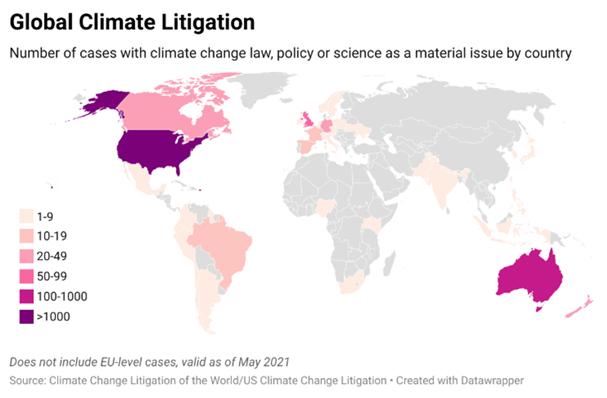
Demand for energy
The combination of growth of global population and industrialization participate to the increase of global demand for energy which accounts for approximately 60% of the global GHG emissions. In this context, the harvesting of energy from RES such as hydropower, solar, wind is critical to meet the objective of Paris Agreement on Climate Change to avoid dangerous climate change by limiting global warming to well below 2°C and pursuing efforts to limit it to 1.5°C.
Hydropower
Hydropower relies on the natural water cycle. It does not require fossil fuel to produce electricity. Water in motion (e.g., river flows, wave, tidal) also known as “kinetic energy” turns the blades in a turbine, and allows to convert kinetic energy to mechanical energy, then into electricity.
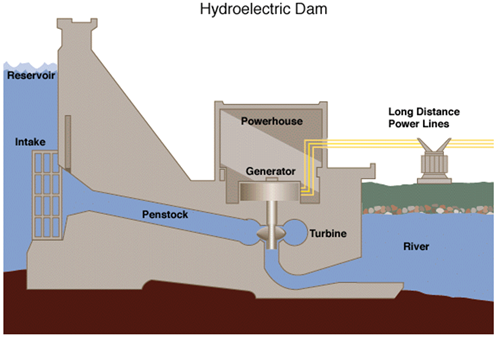
Source: Tennessee Valley Authority
Generally, hydroelectric generation is considered “climate friendly”. In its sixth assessment report on climate change[1] of 2021, the highly respected Intergovernmental Panel on Climate Change (IPCC) acknowledges the importance of hydropower in not only helping to meet the world’s growing electricity demand but also reducing GHG emissions.
Hydropower plants’ dispatchable power source, competitive power generation cost, and overall power density explain why it is the most popular RES and accounts for 16 % of the world’s power generation, just behind coal and natural gas.
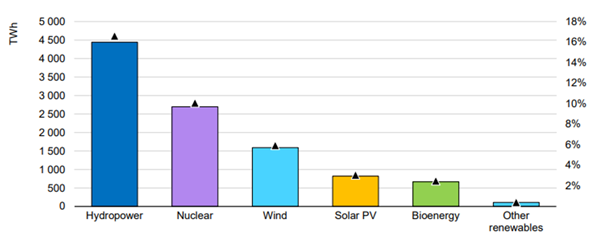
Source: IEA, Hydropower Special Market Report Analysis and forecast to 2030[2]
Power generated through hydropower plants increased slightly in 2021 to 4,414 terawatt bars (TWh), up from 4,360 TWh in 2020, while 14 GW of capacity was added in 2021 and 17 GW in 2020. The trends for upcoming decades foresee a significant expansion of hydropower to reach approximately 6,000 TWh by 2050, with China and Brazil leading that growth.

Source: U.S. Energy Information Administration, International Energy Outlook 2021[3]
Hydropower plants’ adverse effects
From their construction to demolishing, hydropower plants pose well documented risks to the environment. Those impacts include deforestation, land clearing, loss of habitat, water evaporation, muck dumping, siltation, flooding of the habitat of animals, prevention of free movement of fish, retention of minimum level of water in the bed during dry seasons, aquatic pollution, displacement of population. Not all hydropower plants generate the same level of risks. The severity of the impacts on the environment mostly depends on the type, age and size of a plant.
Hydropower plants’ negative effects on the environment and climate
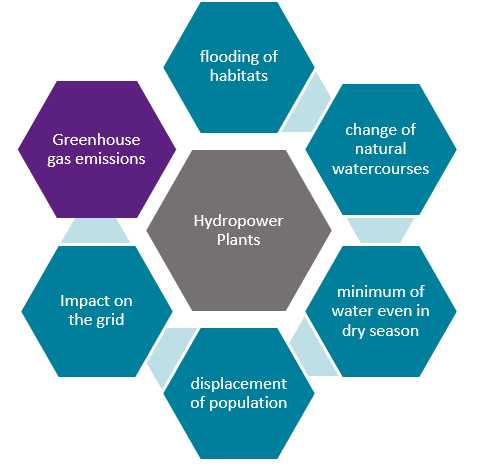
Source: author’s own figure
In some cases, the adverse effects have led to successful lawsuits. For example, in 2020 the Supreme Court of the Slovak Republic has ordered the closure of a hydroelectric power plant based on “The public interest, which is the protection of the environment, takes precedence over private business interest”[4].
Greenhouse gas effects of hydropower plants
While much attention has been paid to the negative effects of hydropower plants on the environment, recent notice has been taken of the GHG emissions they generate. Although cleaner than fossil fuel for generating power, hydropower plants can nonetheless be carbon intensive. This finding comes as a surprise as there is no burning of fuels in operating hydropower plants.
Public and private funded research, in particular a study conducted the Washington State University in 2016[5] and the 2019 EU funded HYDROCARB project have investigated the carbon footprint of hydropower plants. They confirm earlier findings made by Vincent St Louis of the University of Alberta in 2000 that hydropower plants’ reservoirs act as ‘methane factories’, removing CO2 from the atmosphere and returning it as methane with a much greater impact on the climate. According to those studies, CH4 is the prominent GHG produced in dams and results from bacterial decomposition of organic matter in anoxic water and sediment environments created by impoundment.
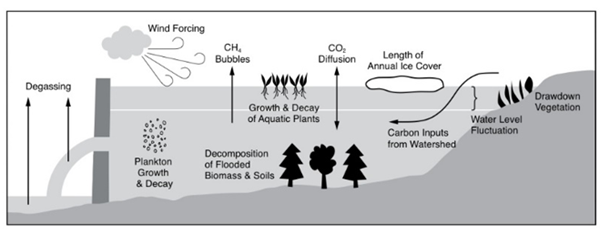
Source: International Rivers, People, Water, Life available at: https://archive.internationalrivers.org/campaigns/reservoir-emissions
Scherer and Pfister estimate that 10% of all hydropower plants emit equal amount of GHGs per unit energy as conventional fossil-fueled power plant.
According to the International Energy Agency’s (IEA) World Energy Outlook 2017 80 kg CO2eq MWh−1 is used as a reference carbon intensity for sustainable electricity generation to achieve the energy goals of the United Nations 2030 Agenda for Sustainable Development. Using this basis, a published article in Nature by Rafael Almeida concludes that in over a 20-year time horizon about 25% of the proposed lowland dams in Amazon may well be more carbon-intensive than coal-fired power plants.
Climate change litigation surge ahead?
Scientific evidence reveals that the GHG emissions of hydropower plants, especially small ones, are substantial, but current policies and regulations seem to underestimate these effects. Until stricter legislations are enacted, lawsuits are likely to increase against hydropower plants following the path of climate related actions lodged against fossil fuel corporations. Last March, a petition was filed with the US Environmental Protection Agency seeking rulemaking requiring hydropower facilities and reservoirs to report their GHG emissions[6].
The Global Methane Pledge launched at COP 26 committing to “achieve all feasible reductions in the energy sector” is likely to exacerbate the rate of lawsuits against methane emitters, including hydropower plants.
Although some hope may come from the launch in 2021 of the Hydropower Sustainability Standard which covers GHG emissions, it remains to be seen to what extend it will be implemented and whether countries will start reporting GHG emissions from dams.
Ultimately, reservoirs planning that considers GHG emissions along with environmental and societal externalities will be critical for mitigating the risk of climate change lawsuits.
The IEA estimates that 40% of the global hydropower plants is at least 40-year-old. Solutions to lower their carbon intensity includes retrofitting plants with improved designs, reducing nutrient inputs to dams, clearing terrestrial vegetation prior to flooding, reducing water evaporation. However, some of those solutions may bring additional risks on the environment while addressing some side effects of hydropower plants. For example, the pairing of hydropower plants with floating solar photovoltaics (FPV) sited directly on waterbodies on one hand helps reducing the rate of water evaporation and GHG emissions and on another hand FPV are known for their adverse effects on the ecosystem.
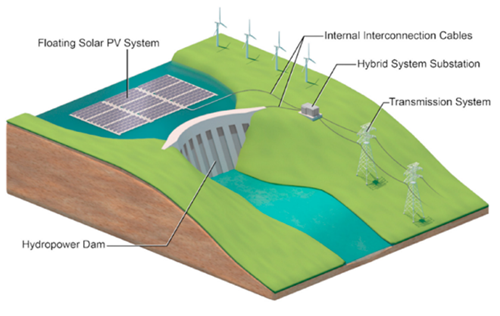
Source: Ursual Grunwald et al. Hybrid floating solar photovoltaics-hydropower systems: benefits and global assessment of technical potential
Bibliography
Almeida, Rafael M et al. “Reducing Greenhouse Gas Emissions of Amazon Hydropower with Strategic Dam Planning.” Nature communications 10.1 (2019): 4281–9. Web.
Asian Development Bank, Climate Risk and Adaptation in the Electric Power Sector 2012, available at https://www.adb.org/sites/default/files/publication/29889/climate-risks-adaptation-power-sector.pdf
Couto, Thiago BA, and Julian D Olden. “Global Proliferation of Small Hydropower Plants – Science and Policy.” Frontiers in ecology and the environment 16.2 (2018): 91–100. Web.
Elisa De Vit, Climate Change Litigation Update, 2020 available at: https://www.nortonrosefulbright.com/en/knowledge/publications/7d58ae66/climate-change-litigation-update
Eric Sorensen, “Reservoirs are underappreciated source of greenhouse gases”, Washington State University September 26, 2016, available at: https://news.wsu.edu/press-release/2016/09/28/reservoirs-play-substantial-role-global-warming/
EU Project Hydrocarb 2019 “Towards a new understanding of carbon processing in freshwaters: methane emission hot spots and carbon burial” available at https://cordis.europa.eu/project/id/336642
Gagnon, Luc, and Joop F van de Vate. “Greenhouse Gas Emissions from Hydropower: The State of Research in 1996.” Energy policy 25.1 (1997): 7–13. Web.
Global Methane Pledge 2021 available at https://www.globalmethanepledge.org/
Guérin, Frédéric et al. “Methane and Carbon Dioxide Emissions from Tropical Reservoirs: Significance of Downstream Rivers.” Geophysical research letters 33.21 (2006): L21407–n/a. Web.
IEA, Hydropower Special Market Report Analysis and forecast to 2030 available at: https://www.iea.org/reports/hydropower-special-market-report
Joanna Stezer et al., Global trends in climate change litigation: 2021 snapshot available at : https://www.lse.ac.uk/granthaminstitute/wp-content/uploads/2021/07/Global-trends-in-climate-change-litigation_2021-snapshot.pdf
Lee, Nathan et al. “Hybrid Floating Solar Photovoltaics-Hydropower Systems: Benefits and Global Assessment of Technical Potential.” Renewable energy 162 (2020): 1415–1427. Web.
Li, Xuerong, Faliang Gui, and Qingpeng Li. “Can Hydropower Still Be Considered a Clean Energy Source? Compelling Evidence from a Middle-Sized
[1] https://www.hydropower.org/blog/ipcc-says-hydro-can-help-mitigate-climate-change-impacts-and-keep-1-5-alive
[2] https://iea.blob.core.windows.net/assets/4d2d4365-08c6-4171-9ea28549fabd1c8d/HydropowerSpecialMarketReport_corr.pdf
[3] https://www.eia.gov/outlooks/ieo/
[4] https://wwfcee.org/what-we-do/freshwater/court-decision-in-small-hydropower-case-the-public-interest-takes-precedent-over-private-business
[5] https://news.wsu.edu/press-release/2016/09/28/reservoirs-play-substantial-role-global-warming/
[6] https://www.spglobal.com/marketintelligence/en/news-insights/latest-news-headlines/conservation-groups-ask-epa-to-require-greenhouse-gas-reporting-for-hydropower-69478502